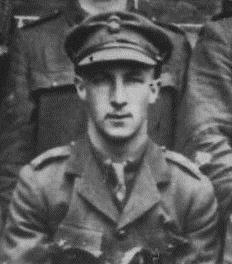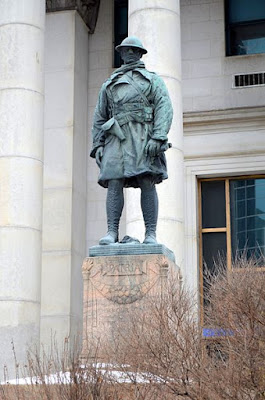The third part of John Sheen's series about the journey of the Tyneside Irish to the Battle of the Somme.
In the last blogpost we left the Tyneside Irish Brigade learning the art of trench warfare. Throughout February and into March 1916, each of the four battalions spent four days in the line at a time. They rotated so that there were two battalions in the line, and the two out of the line spent four days in Brigade Reserve and then four days in Divisional Reserve. This was sometimes known as “rest” but it was far from resting. Nightly carrying parties had to be found to take ammunition, duckboards, sandbags, food, water and hundreds of other items up to the men holding the front line.
 |
| Recruitment poster for the Tyneside Irish, used under the IWM Non-Commercial Licence, © IWM (Art.IWM PST 13620) |
By the middle of March the 27th Battalion (4th Tyneside Irish), Northumberland Fusiliers, were holding the line once more. On the night of the 15/16 March, a German patrol planted a German flag in front of them. During the day, the battalion snipers shot at the pole, eventually bringing the flag down. Plans were made to try and recover it during the night, and the company commander, Captain Davey, had no shortage of volunteers to go out and capture the flag. He therefore chose the best man for the job, Lieutenant CJ Ervine, together with two men of his platoon but after an hour or so, the party returned without the flag. The enemy were too alert and waiting, and had a patrol covering the flag on one side and a machine gun covering the other. When the three Tyneside Irishmen got to within twenty-five yards of the German flag there was such an outburst of firing that they had to return to the British lines. In the early hours of St Patrick's Day, Lieutenant Ervine set out again, this time alone and for half-an-hour those in the British trenches waited, until Lieutenant Ervine's platoon sergeant went out to the wire to look for him. At 2:45pm the Germans fired a star shell and those in the trench could see the dark shape of Lieutenant Ervine making his way slowly back to the British lines having managed to recover the prize, but on the way having fallen into a ditch full of muddy water.
While Ervine dried himself, Captain Davey and another officer erected a stout pole with the German ensign nailed to it, and above the ensign the green flag with the golden harp, which had been presented to the Company prior to leaving England. As day broke the Germans started to shoot at the pole in a vain attempt to bring it down, but there it hung throughout St Patrick's Day, attracting admiring visitors to the Tyneside Irish trenches from other parts of the line. Unfortunately, shortly after this episode, Lieutenant Ervine, who hailed from Belfast, was badly wounded and succumbed to his wounds soon afterwards. He was interred in Bailleul communal cemetery.
But the fire attracted by the flag, from the German sniper's was to have tragic consequences for some of those on duty in the trenches that St Patrick's Day. Early that morning 27/26 Private William Brown and 27/663 Private John Scollen took over sentry duty at a post in the front line. At about 4:15 a.m. the pair were about to be relieved, when a shot from a German soldier hit William Brown in the
head, the round ricocheted and then hit John Scollen in the face. As William fell to the floor of the trench, John could see he was badly wounded and needed help urgently. Forgetting his own wounds John Scollen rushed down the trench to the Aid Post. He turned out the stretcher bearers and led them back to the front line to where William Brown now lay unconscious, but still alive. The wounded man was placed on a stretcher and evacuated as quickly as possible, however, although he reached the aid post, he died before the battalion doctor Lieutenant Cosgrave could reach him.
 |
| Lieutenant EJ Blight, Northumberland Fusiliers, extracted from a group photo in the John Sheen Collection |
Mrs Ada Brown, who lived at Grange Villa, County Durham, was told of her husband’s death in a letter from Captain Davey, who told her of Private Scollen's attempt to save her husband. She also received a letter from his platoon commander Lieutenant Ernest Blight, who wrote,
Dear MadamIt is with very great regret that I have to inform you that your husband lost his life on Friday March 17th at about 4:15 in the early morning. He was on sentry in his bay in a trench very close to the Germans, when a bullet struck him. His comrades took him to the dressing station as fast as possible, but the wound proved fatal. I have not been in charge of this platoon for very long, but during the short time I had your husband under my charge, I was able to see that he was a good soldier and a fearless man. He did his duty thoroughly and died bravely for a worthy cause. I hope that you will be given health and strength to bring up your family and that you will bear up as well as can be expected during this great trial.I am yours faithfullyEJ Blight, Lieut.
Mrs Brown had another letter, from Lieutenant Ralph Pritchard. Although he was now serving as a Captain in D Company it was less than a fortnight since he had been Private Brown's platoon commander in B Company. Lieutenant Pritchard described William Brown as "one of the most cheery men in the company". He goes on to say "No matter how hard the day's work had been [William Brown] always looked upon the bright side and if a laugh was possible Brown always gave it. Trying to ease Mrs Brown's loss he went on to write, "An officer often finds inspiration amongst his men and I am sure your husband's cheerfulness and large heartedness were a source of inspiration to me and helped me very considerably more than once. You will feel his loss keenly I know but I hope that God may give you strength to bear up in this very hard time".
 |
| Lieutenant Ralph Pritchard, Northumberland Fusiliers, extracted from a group photo in the John Sheen Collection |






